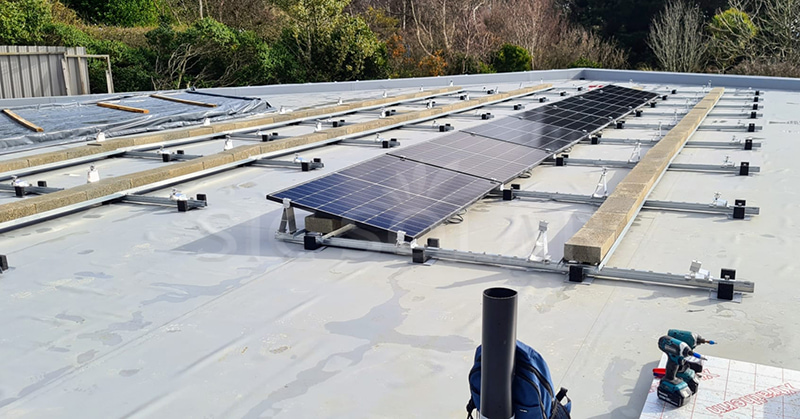When it comes to installing solar panels, choosing the right roof configuration is essential for maximizing efficiency and ensuring long-term performance. A well-optimized roof setup not only enhances solar energy generation but also helps reduce installation costs and extend the system’s lifespan.
Key Factors Influencing Roof Configuration for Solar Panels
1. Roof Orientation: South or North Facing
The orientation of your roof is a critical factor in determining the best configuration for solar panels. In the Northern Hemisphere, solar panels should ideally face true south, while in the Southern Hemisphere, they should face true north. This positioning ensures that the panels receive the maximum amount of sunlight throughout the day.
– South-facing roofs in the Northern Hemisphere receive direct sunlight from morning to late afternoon, making them the most efficient orientation for solar panels.
– North-facing roofs in the Southern Hemisphere are similarly beneficial, as they receive consistent sunlight throughout the day.
– If your roof faces east or west, it can still be used for solar panels, but the efficiency may be slightly lower. East-facing panels will capture morning sunlight, while west-facing panels will capture afternoon sunlight. However, this results in reduced energy production compared to a south-facing setup.
SIC Solar offers a variety of solar mounting solutions that allow for precise adjustments to panel positioning, ensuring that even non-ideal orientations can still achieve optimal results.
2. Roof Pitch (Angle of the Roof)
The pitch or tilt angle of your roof significantly impacts the performance of your solar panels. Ideally, solar panels should be installed at an angle that aligns with the latitude of your location. This ensures that the panels are positioned to capture the most direct sunlight throughout the year.
– In regions with a low latitude, a steeper angle (around 30-40 degrees) may be necessary to capture sunlight during the winter months when the sun is lower in the sky.
– For regions near the equator or those with a high latitude, a shallower angle (around 15-20 degrees) might be more appropriate to take advantage of higher sun angles during the summer months.
– If your roof has a flat pitch or if the slope is too shallow, you may need to use adjustable mounting systems that elevate the panels to the optimal angle. SIC Solar provides high-quality solar mounting systems designed for both pitched and flat roofs, helping you achieve the perfect tilt for maximum energy generation.
3. Roof Material and Structural Integrity
The type of roofing material plays a significant role in determining the best mounting solution. Different roofing materials, such as metal, asphalt shingles, tile, and flat roofs, have specific requirements for solar panel installation.
– Metal roofs are excellent for solar panel installations because they are durable and easy to secure with roof-mounted solar hooks or mounting brackets.
– Asphalt shingles are also suitable for solar installations, and SIC Solar offers compatible mounting systems designed for shingle roofs.
– Tile roofs require special attention when installing solar panels, as the tiles can crack or be damaged during the process. Custom mounting solutions, such as roof hooks or flashing kits, can help protect the tiles while securely mounting the panels.
– Flat roofs may need ballast mounting systems or ground screws to ensure stability and secure positioning without damaging the roofing material.
Ensuring that your roof is in good condition and capable of supporting the weight of the solar panels is essential for a safe and successful installation. SIC Solar’s high-quality mounting systems are compatible with various roof materials, providing secure and efficient solutions tailored to your needs.
4. Space for Solar Panels
The available space on your roof is another important consideration when determining the best configuration. Solar panels require ample space for both the panels themselves and adequate spacing between them to prevent shading and ensure proper airflow.
– For sloped roofs, panels are typically installed in rows, with the optimal distance between them to avoid shading. The rows should be arranged to ensure that the panels are not overshadowed by nearby structures, chimneys, or other obstacles.
– For flat roofs, panels can be arranged in an array using ballast-mounted systems or ground screws. These mounting systems are particularly effective for maximizing the available space and achieving the correct tilt without needing to penetrate the roof.
SIC Solar offers a variety of roof-mounted and ballast-based mounting systems that ensure a secure and efficient layout of solar panels, regardless of the roof type.
5. Shading and Obstructions
Shading is a key factor that can significantly impact the performance of your solar panels. Any obstruction, such as trees, chimneys, or nearby buildings, can cast shadows on the panels and reduce their efficiency. When selecting the best roof configuration, it’s important to evaluate the solar access throughout the day.
To minimize shading, choose a roof area that is free of obstructions and position the panels where they will receive the maximum exposure to sunlight. SIC Solar’s mounting systems allow for flexibility in positioning, making it easier to adjust panel placement to avoid shading and maximize energy production.
Recommended Roof Configurations for Solar Panels
1. South-Facing Roof (Northern Hemisphere)
A south-facing roof with a pitch matching the local latitude is the ideal configuration for solar panels. This setup ensures maximum sunlight exposure throughout the day.
2. Flat Roof with Ballast Mounting
For buildings with flat roofs, a ballast mounting system can be used to secure the panels without the need for drilling into the roof. This configuration is ideal for commercial buildings or large installations.
3. Pitched Roof with Adjustable Mounting Systems
For homes or businesses with sloped roofs, adjustable mounting systems ensure that panels are positioned at the optimal tilt angle, improving energy generation year-round.
4. East or West-Facing Roofs with Optimized Spacing
If your roof faces east or west, solar panels can still be installed with a slight reduction in efficiency. Ensuring proper panel spacing and avoiding shading will help optimize energy production.
